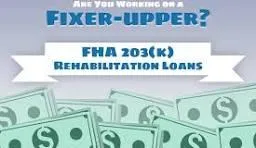
FHA 203(k): Unlocking Hidden Housing Market Potential
FHA 203(k): Unlocking Hidden Housing Market Potential
Most buyers walk past the ugly houses. That's exactly why they might be the answer to our housing crisis.
In a market where inventory feels impossibly tight and prices continue to climb, there's a forgotten category of homes sitting untouched. These properties need work – sometimes a lot of it – and conventional financing won't touch them.
Enter the FHA 203(k) rehabilitation loan program, perhaps the most underutilized tool in today's housing market.
The 2025 Game-Changer Nobody's Talking About
The Department of Housing and Urban Development has dramatically expanded the 203(k) program for 2025. After nearly three decades of stagnation, they've raised the Limited Rehab loan cap from $35,000 to $75,000.
This isn't a minor adjustment. It's a recognition that renovation costs have fundamentally changed since 1995.
Even more revolutionary? Buyers can now include up to 12 months of mortgage payments in their loan. This means you can purchase a property that needs significant work, finance the renovations, and delay making mortgage payments for up to a year after closing.
Think about what that means for first-time buyers.
How 203(k) Loans Transform Dilapidated Houses Into Affordable Housing
The math is compelling. Fixer-uppers often sell at steep discounts – as much as 42% below comparable move-in ready homes.
Consider a property worth $250,000 after renovations that sells for $200,000 because it needs $20,000 in repairs. That creates $30,000 in potential equity for someone willing to manage the renovation process.
The 203(k) loan finances both the purchase and the repairs in a single mortgage with a down payment as low as 3.5%.
But the program isn't just about individual opportunity. It serves a broader economic purpose.
"These changes will help return older, dilapidated homes into owner-occupied housing stock, and help first-time buyers compete with fix-and-flip investors," says Pete Mills, SVP of residential policy at the Mortgage Bankers Association.
The Structural Advantage That Makes This Work
Traditional mortgages have a fundamental limitation: they require properties to be in livable condition. This creates a catch-22 for many potential homebuyers.
They can't get financing for homes that need significant work, but those are precisely the properties they might be able to afford.
The 203(k) program solves this by allowing buyers to borrow based on the property's future value after improvements, not its current condition.
You can borrow up to 110% of the property's proposed future value, or the home price plus repair costs, whichever is less.
Time: The Hidden Benefit of Recent Changes
Renovation projects rarely go exactly as planned. Unexpected challenges emerge once walls are opened and systems are exposed.
Recognizing this reality, HUD has extended the rehabilitation period from six months to 12 months for the Standard 203(k) and nine months for the Limited program.
This provides breathing room for homeowners and contractors, reducing the pressure that leads to rushed, subpar work.
Who Benefits Most From These Loans?
First-time homebuyers stand to gain the most. In markets where move-in ready homes have become unaffordable, the 203(k) loan offers an alternative path to ownership.
It's also valuable for buyers in competitive markets who keep losing bidding wars. The homes that need work typically attract fewer offers.
Owner-occupant investors can use the program for properties with up to four units, provided they live in one of them.
The Limitations You Should Know
The 203(k) program isn't perfect. It comes with more paperwork than conventional loans. The approval process takes longer. And you'll pay mortgage insurance premiums.
Luxury improvements like swimming pools and tennis courts aren't eligible. The focus is on making homes safe, functional, and energy efficient.
Despite these limitations, the program remains dramatically underutilized. 203(k) loans made up less than 1% of FHA loan endorsements in fiscal year 2023.
Why This Matters for the Broader Housing Market
Housing affordability has reached crisis levels in many parts of the country. The solution requires both new construction and better utilization of existing housing stock.
HUD Deputy Assistant Secretary Sarah Edelman notes that the updated 203(k) program helps "more families find homes where they want to live" because "homes that are often affordably priced need some work."
When buyers can transform properties that would otherwise remain vacant or fall into disrepair, they're not just creating personal wealth. They're revitalizing neighborhoods and expanding the effective housing supply.
The Strategic Advantage for Forward-Thinking Buyers
The housing market has conditioned most buyers to focus on move-in ready properties. This creates a strategic opportunity for those willing to take a different approach.
While others compete for the same limited inventory of pristine homes, 203(k) borrowers can access a separate pool of properties with less competition.
They're not just buying a house. They're buying potential at a discount.
And with the expanded program limits and extended renovation timelines, that potential has never been more accessible.
Unlocking the Future of Housing
The FHA 203(k) program won't single-handedly solve our housing challenges. But it represents an important piece of the puzzle that has been largely overlooked.
By enabling more buyers to see value where others see problems, it expands the effective housing inventory without waiting for new construction.
In a market defined by scarcity, that's a powerful proposition.
The ugly houses might just be the beautiful solution we've been looking for all along.
To learn more about the FHA 203(k) rehab loan visit https://203k.crystalmeyer.com/
